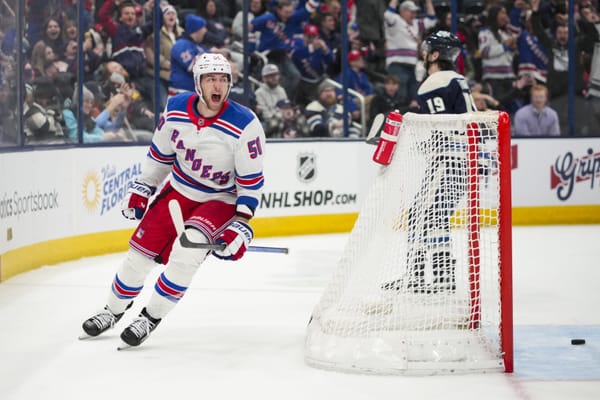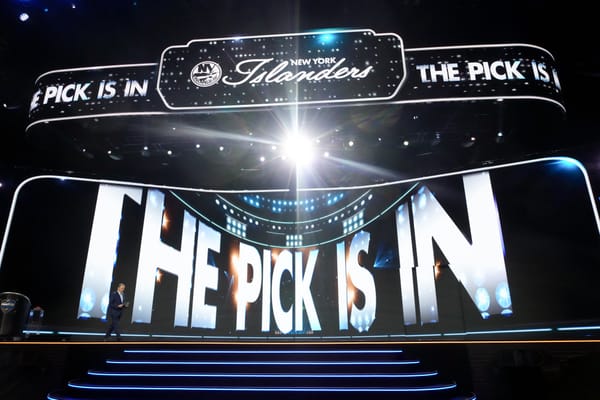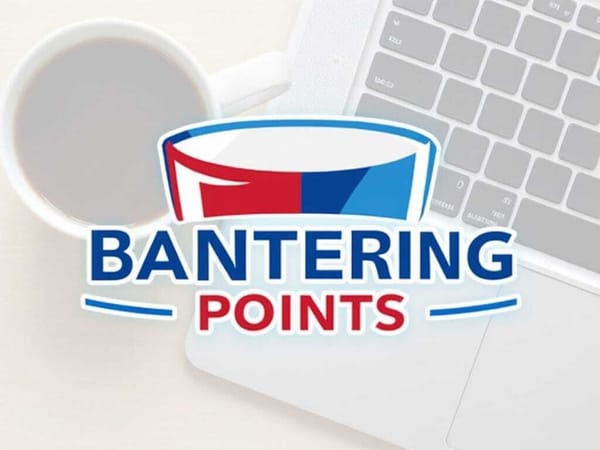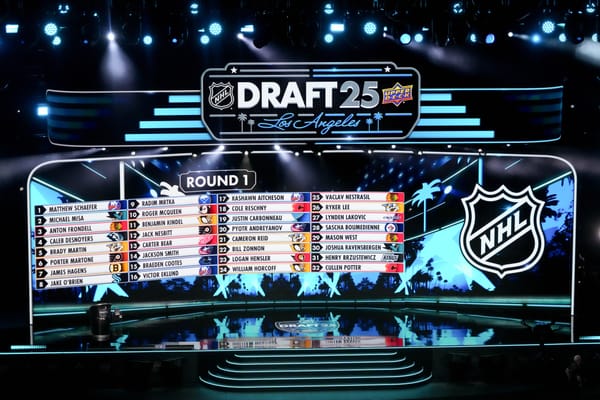2019 Report Card: Mika Zibanejad
There’s a reason why Mika Zibanejad received the highest grade from Blueshirt Banter this season — he was just so damn good.
Zibanejad became the New York Rangers’ first line center last year, in his second year with the team. Throughout last season, he proved that it was a role he could continue to grow into. But after a year of adjustment both to that role and a new team — which was derailed by a significant injury — the 2018-19 season was his year to prove that he was truly a first line center in the NHL. And he did just that, with 74 points in 82 games, and setting a number of new career highs.
This year, in all situations, Zibanejad scored 30 goals, three ahead of his career-best from 2016-17. His 44 assists also surpassed his previous high of 30 (2015-16) by 14. Those 74 points crushed his previous best of 51 points in a season (2015-16), while his 23 power play points, 392 shot attempts, and 236 shots on all, were all new high-water marks for the Swedish center.
His power play scoring grabs the most attention, and part of that is because of how dismal the Rangers’ man-advantage has been over the years; having someone as dynamic as Zibanejad on the power play is worth talking about. Having said that, his even strength play can’t be overlooked, nor can his overall two-way game. This season, Zibanejad took strides in his 5-on-5 production. He fell one goal shy of of matching his career best with 14 goals at 5-on-5, but his 25 assists were the highest of his career. Zibanejad’s 231 shot attempts and 140 shots on goal at 5-on-5 were also the highest of his career.
Zibanejad also played the most ice time of his career last season; in all situations he averaged 20:33, a significant growth from the 17:57 he averaged in his first year with the Rangers. At 5-on-5, he played almost a minute and a half more than last year, with 14:25 minutes on average. Zibanejad took that increase in ice time and ran with it, as exemplified by his growth across the board. Lest you think that growth was only a result of more ice time, he also set a new bar for himself with his 2.63 points per 60 in all situations.
Those numbers compared well not just to his previous seasons, but also to his teammates last season.
The rebuilding 2018-19 Rangers weren’t exactly the most inspiring group, but that shouldn’t take away from what Zibanejad accomplished this season. He was one of, if not the brightest spot of the season.
Zibanejad’s 74 points led the team by a margin of 22 points. Chris Kreider finished second. He played three fewer games and dealt with more injuries than Zibanejad; it’s also worth mentioning that he wasn’t credited for his involvement in goals that he provided essential screens for. Still, the margin between Zibanejad’s 74 points and Kreider’s 52 points speaks volumes about what the center meant to the team.
Zibanejad’s 30 goals led the team, with Kreider trailing, and Pavel Buchnevich behind both of them at 21. His 44 assists were also the best of the team, with Kevin Hayes pre-trade deadline trailing at 28, Mats Zuccarello’s pre-deadline 26 behind them, and defenders Tony DeAngelo’s (61 games) and Kevin Shattenkirk’s (73 games) next.
His scoring doesn’t just compare well to what other Rangers accomplished this year, but also to recent noteworthy from Rangers players. Zibanejad was the first Ranger to reach the 70-point mark since Marian Gaborik did in 2011-12 with his 76 points. His 30 goals were the first from a Rangers since Rick Nash netted 42 in 2014-15. Compared to centers, his scoring was even more impressive, since no Ranger center has put up 70 points since Scott Gomez achieved that feat in 81 games in 2007-08. Until Zibanejad this past season, no Ranger center had tallied 30 goals since Eric Lindros scored 37 in 2001-02.
Along with his scoring,Zibanejad led the Rangers in both shot attempts and shots on goal, with Kreider trailing in both categories. Zibanejad’s 170 individual scoring chances were second to Kreider’s 213; his individual expected goals of 19.5 ranked third behind Kreider and Jimmy Vesey. Zibanejad also led the team with 69 takeaways and was second on the team in hits absorbed (131), which may be indicative of how much he possessed the puck. Based on how much he fired the puck on net, it’s clear that he maintained it despite those hits, and when he couldn’t hold on to it, those takeaways show his ability to regain it.
Those shots often came from the left circle, where he was not shy about firing away with wrist shots, slap shots, and one-timers. It was particularly effective on the power play. With him on the ice for the man-advantage, the Rangers generated most of their offense from the circle or in front of the net, which can indicate that Zibanejad shot the puck a lot and that his frequent screen-provider Kreider would either finish his shots or get it on net with a second effort. Zibanejad also was able to bring the puck in for higher danger opportunities.
On the power play, Zibanejad took 116 shot attempts, which was sixth among NHL centers on the man advantage; the 70 shots that reached the net ranked fifth. If we widen the scope to all forwards, those shot attempts rank 15th in the league, and in shots he ranked 11th.
It’s also worth noting that Zibanejad spent a fair amount of time playing without two of the team’s best passers, as he didn’t always have Buchnevich or Zuccarello on his wing whether it was due to injuries or lineup decisions. While both were out with injury, he wasn’t scoring as often, which may be because he didn’t have someone to thread a pass to him that gave him time and space to get a quality shot on net. Zibanejad also wasn’t shy about taking shots wherever he could find them. However, he still managed to be dangerous with or without the puck on his stick even when his name wasn’t on the scoresheet after a game.
For as much as we talk about Zibanejad’s shooting and goal scoring, we don’t praise his ability to move the puck nearly enough. Whether it was to Zuccarello, Buchnevich, Kreider, Vlad Namestnikov, or another teammate, Zibanejad displayed a lot of creativity while dishing the puck. It’s an underrated aspect of his game, since he’s rightfully thought of as the Rangers’ big right-handed shot on a team that is filled with players who could stand to shoot the puck more often.
That shooting and passing also extends to when he had less space when at even strength. At 5-on-5, Zibanejad’s 39 points and 25 points were the highest on the team. His 14 goals in that situation were second to Kreider’s 19. He also led the team with 50 takeaways.
Below the surface, Zibanejad was solid as well. His 48.09 percent Corsi was third among the Rangers (excluding Hayes and Zuccarello pre-deadline). While not breaking even in the shot share isn’t usually something to celebrate, on a team like the Rangers who struggled on both ends of the ice, it’s worth noting. In terms of expected goals, he just broken even with at 50.57 percent, behind only Kreider and Shattenkirk.
In terms of both Corsi and expected goals, his numbers against stood out and showed how well-rounded his game really is. For all that Zibanejad can produce offensively, he is still a two-way center due to his strong play in his own zone. And with those takeaways in mind, how he was able to shift back to offense and transition the puck up the ice was also noteworthy.
That two-way play translated to the penalty kill as well, which was particularly handy for the Rangers after the Zuccarello and Hayes trades.
With everything in mind — from all of the career highs, to how he measured up to his teammates, and to the rest of the league — it’s easy to to give Zibanejad the highest marks.
He may never compare to some of the elite first-line centers in the league, but he was never expected to. This is a player that was projected to be closer to a second-line center that’s transformed his game when he was promoted. His extremely reasonable cap hit along with his age, and the growth in his game are all encouraging signs that he will be a key piece of this rebuilding team for years to come.
Final Grade: A+
Banter Consensus: A+
All data via NaturalStatTrick
2019 Report Cards: Ryan Strome / Filip Chytil / Brendan Lemieux / Tony DeAngelo / Chris Kreider / Pavel Buchnevich / Neal Pionk / Cristoval Nieves / Kevin Shattenkirk / Marc Staal / Jimmy Vesey / Brady Skjei / Connor Brickley / Vladislav Namestnikov/ Vinni Lettieri/ Brendan Smith / Fredrik Claesson / Assistant Coaches / Henrik Lundqvist / Alexandar Georgiev




